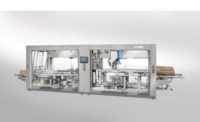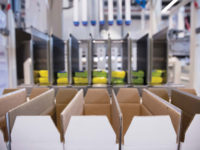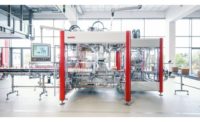Retail-ready packaging brings branding and convenience

courtesy of Douglas Machine Inc.

courtesy of Delkor

courtesy of Blueprint Automation

courtesy of Colborne Foodbotics

courtesy of Charles Downer & Co. Ltd.

courtesy of Charles Downer & Co. Ltd.






Retail-ready packaging (RRP) solutions range from large corrugated boxes with loose packages to smaller, notched paperboard holders for stand-up display of carded packages. Retailers benefit from RRP because it gives them shelf-ready inventory in seconds, cutting the time it takes to check in and stock shelves. Benefits to bakery/snack producers include maintaining market presence and account viability.
Both manufacturers and retailers want RRP (also known as shelf-ready packaging) that’s appealing to the consumer—an easy-to-open RRP solution with a clean, finished, machine-cut front display with strong branding. The retailer benefits by having an easier method of getting product on shelf. This includes lower overall labor cost, more-consistent appearance once the products are on-shelf and ease of stock rotation for freshness. All of these factors help reduce the potential for out-of-stock scenarios.
“RRP offers a means of presenting data more clearly to the customer. Some market segments utilize colored trays to help guide the shopper to make a quicker purchase decision, and some retailers have achieved some levels of sales growth in categories that they have converted to shelf-ready packaging,” says Rick Gessler, director of marketing and strategic account management, Delkor, St. Paul, MN.
RRP will initially cost producers more to implement and redeploy their production lines, according to Rocco Fucetola, vice president of sales and marketing, BluePrint Automation, Colonial Heights, VA. “However, those that do will create a better cost basis and become better equipped to stay price-competitive into the future.”
Materials and styles
A variety of packaging materials and styles common to snacks and baked goods are well-suited to shelf-ready packaging. Cookies, crackers and chips are all strong candidates for RRP.
Generally, products shelved in pouches or bags are candidates for RRP. “Over the last 12 months, Fisher Nuts converted its retail presence for baking nuts to the Delkor Cabrio Case,” says Gessler. “Powdered baking/cake mixes, frosting pouches—including those with fitments—also are prime candidates. As the conversion from cartons to pouches continues in these markets, so too will the growth of RRP.”
Wayne Slaton, senior director of sales, Douglas Machine Inc., Alexandria, MN, sees a wide variety of packaging materials, ranging from film, corrugated and paperboard, as well as a combination of printed substrate and corrugated, in two-piece RRP packs. “Lids can be inside-of-tray, outside-of-tray or used to combine multiple trays in one lid. We certainly see more single- and double-facing stand-up pouches as the market grows,” he says.
Retailers are receptive to self-standing, kiosk-style RRP options that could be used to merchandise products in various parts of the store, Slaton adds. “However, this really comes down to slotting requirements and price points. In most instances, the manufacturer of the product maintains these packaging options. As requirements differ significantly, these island displays can be a challenge to automate and expensive to the bakery manufacturer.”
Slaton sees several RRP trends in bakery/snack operations, such as tray-lid applications—for label visibility—where the lid is easily removed without knives to leave clean-edged trays for retail use exposing product graphics. In addition, he sees more film-wrapped products for multi-pack and use in the warehouse/club channel. These packages are typically printed film that covers individual carton UPCs.
“Portion-pack cups are being presented in dairy-style display trays for maintaining product exposure,” says Slaton. “We see more stand-up pouches for products that were traditionally flat packed being displayed in a stand-up style. They may be positioned in a paperboard tray with a corrugated lid.”
Ledge trays—stackable display trays with interlocking nesting tabs—are a big trend, according to Jeff Downer, managing director, Charles Downer & Co. Ltd., Richmond Hill, Ontario. These stackable/interlocking RRP display trays are assembled from a flat blank, then loaded and sealed, ready for palletizing.
RRP innovations
Charles Downer & Co. offers a full range of Bosch case packers—from wrap-around to side-load and top-load case packing systems—used to create RRP. For example, the Elematic Wrap-around case packer handles tray, ledge tray, full wrap-around and tray with hood styles. “Bosch case-packing technology allows more tolerance for variation in corrugated board quality, which enables manufacturers to source packaging material from a greater number of suppliers, enhancing supply-chain reliability and reducing costs,” Downer says.
The Douglas Vectra and Vantra IM Cartoner platforms from Douglas Machine Inc. offer the flexibility to run multi-packs for RRP. Its line of Invex IM and Axiom corrugate machines lend themselves to a variety of product orientations. “These machines can manipulate several product orientations to satisfy traditional distribution and retail-ready products without limiting speeds on production lines,” Slaton says. Other Douglas machines are designed to handle pouches and cartons that service the bakery industry.
BluePrint Automation offers several RRP solutions, according to Robbie Quinlin, marketing manager. “By using our traditional 2-axis pick and place, we can pack various retail-ready configurations—one, two or three-sided displays. This is achieved by loading product into an intermediary cassette, then side-loading it into the erected retail-ready case.”
Blueprint Automation recently designed a retail-ready case that can be erected, case-packed and closed like a traditional, regular slotted container (RSC) case. This gives snack producers and bakeries the ability to run both traditional RSC and retail-ready cases on the same machine. Case packing is achieved by using a Delta-style robot, with or without vision.
Rick Hoskins, vice president, Colborne Foodbotics, Lake Forest, IL, says more bakeries are using a folding-bar tray that is ideal for merchandising baked goods directly in the route tray that is loaded at the store. The tray is designed with a folding-bar design that allows for a 360-degree view of the product. “The bar is upright and locked in position, so users can load and stack the tray with product. When empty, the bars are folded into the tray so users can easily stack empty trays for transport back to the bakery,” he explains.
Colborne Foodbotics offers equipment that allows full automated handling of these folding-bar trays, automating the unstacking, bar opening and basket integrity inspection process at high speeds. “Because of the tray design, the footprint of the bars is smaller than the surface area of the tray,” says Hoskins. “This requires an end effector that manipulates the product in a way to clear the bars and get the product into the tray.”
To help solve problems associated with small sizes that have become popular with RRP, Delkor has introduced the Twin Cabrio Case. This configuration allows the producer to join two RRPs into a single shipper for optimal palletization and stability during distribution. Upon arrival at the shelf, the single shipper is easily opened to reveal shelf displays that can be arranged to best suit the shelf space. The front of the display is pre-cut by the corrugated board supplier to ensure that there are no jagged edges or protruding flaps that could negatively impact shelf appearance.
Drawing attention
To draw more attention to RRP innovations, Lindar Corp., Baxter, MN, has introduced OPTICA, an adhesive label material with 3D motion graphics. “Imagine a 3D motion graphics label that shifts from one photo to another as a customer passes by,” says Dave Fosse, director of marketing. For example, packaging images could shift from ingredients to the finished product, all on one label. “These graphics bring more attention to the product,” he says.
Further augmenting the RRP experience for consumers, Bedford Industries, Worthington, MN, offers a Double-Wire Tin Tie, which is suitable for grab-and-go products in stand-up bags and pouches. The closure offers retailers and consumers a bag reclosure feature that keeps products fresh, according to Beth Radloff, marketing specialist. Bedford offers an array of standard tie colors along with custom colors and printed tie for branding.
Snack producers and bakeries can integrate RRP production equipment into a fully automated packaging line. Charles Downer & Co. supplies single machines, such as case packers, as well as entire end-of-line systems.
Also, some companies, including Blueprint Automation, can integrate equipment with other OEMs to provide a complete turnkey packaging solution.
Retail-ready packaging insight from Georgia-Pacific
Nothing speaks louder than packaging at point-of-sale. It can immediately attract the attention of shoppers and promote the benefits of a product—which directly impacts consumer preference. Every detail matters.
In order to learn more about the potential for retail-ready packaging in today’s snack and bakery market, we reached out to Alex Green, vice president, consumer packaging, Georgia-Pacific Corrugated, Atlanta.
Douglas J. Peckenpaugh: Why is retail-ready packaging important to the snack industry?
Alex Green: The snack food industry is among one of the four most innovative categories according to the 2016 “Food Packaging Trends” report by PMMI, The Association for Packaging and Processing Technologies. Manufacturers are continuously turning to recycled and biodegradable materials for salty snacks, as well as stylish, vivid graphics and shapes for single serve packs. The industry is also expected to outperform the market with over 3 percent growth. As noted in the report, key drivers for this expansion include demands for more single-serve and convenience features as well as new product introductions in non-traditional snack categories such as cheese and nuts.
As the demand for snack products increases and packaging continues to play an important role in the success of a product, brand owners are welcoming new ways to innovate their packaging and enhance their brands’ presence on retail shelves.
DJP: Is the use of retail-ready packaging increasing?
AG: Valued at over $58 billion in 2015, the retail-ready packaging market is expected to exceed $71 billion by 2023, growing at more than 3 percent CAGR from 2016 to 2023, per PMMI. More product visibility and brand retention are predicted to be key drivers to influence the increased adoption of retail ready packaging.
DJP: What are the benefits of retail-ready packaging?
AG:The approach offers many advantages, including catering to retailers due to its easy transportation, reusability and recyclability benefits. Additionally, the increased trend of using sustainable or eco-friendly materials and the demand for innovative, lightweight materials that addresses performance, cost and environmental concerns are also significantly influencing the growth of retail ready packaging.
From a packaging perspective, it is essential for brand owners to stay up to speed with product innovation and category trends. This is especially true for the snack industry as it continues to evolve and present greater opportunities for brand owners. The right packaging can be a significant force to spark consumer interest in the product and engage new shoppers.
DJP: How is Georgia-Pacific helping meet the needs for retail-ready packaging?
AG: To enhance the aesthetic appeal of retail-ready packaging and communicate the identity of a brand, Georgia-Pacific provides a wide range of offerings that make products easy to identify, easy to open, easy to shop, easy to replenish and easy to recycle. This is demonstrated by the company’s Brand Ready Packaging (BRP) solution. It employs a series of significant enhancements proven to drive consumer purchase intent, enhance the shopper’s experience and ultimately increase sales over industry-standard retail ready packaging options. Bud’s Best Cookies, for example, had a 14 percent increase in sales with Georgia-Pacific’s BRP solutions. It can make packaging perform at the key in-store “moment of choice,” helping increase brand presence while meeting the demands of retail-ready packaging requirements from retailers.
With decades of experience supporting brands of all sizes and across a spectrum of consumer product categories, Georgia-Pacific is also the first provider in North America that offers digitally printed corrugated capabilities. This helps brand owners maximize the potential of their packaging as a marketing tool to differentiate their products with exclusive, seasonal or regional offerings.
The acquisition of Excel Displays & Packaging, which took place in March, enhances GP’s capability to help customers drive consumers to their brand. Established in 1989, Excel is an innovative designer and manufacturer of award-winning point-of-purchase displays, high-graphic retail packaging, in-store signage and industrial packaging. This acquisition brings new capability in point-of-purchase displays, digital print capability and an additional converting plant.
Looking for a reprint of this article?
From high-res PDFs to custom plaques, order your copy today!












